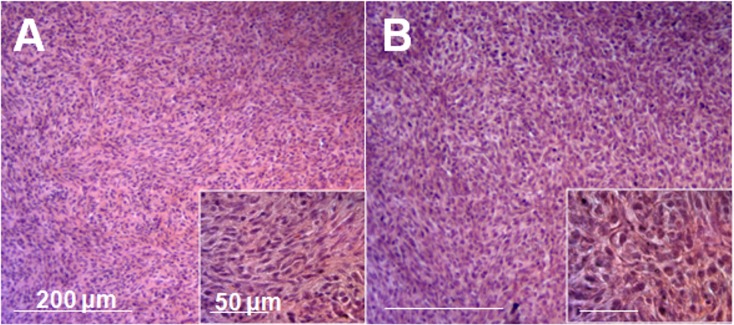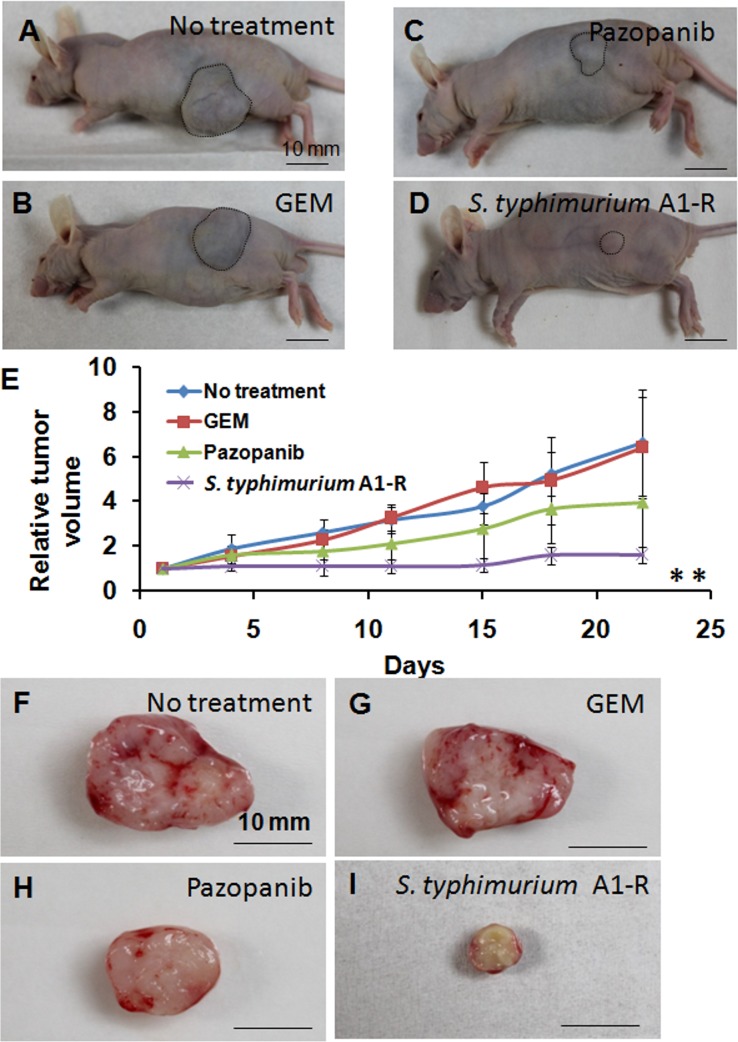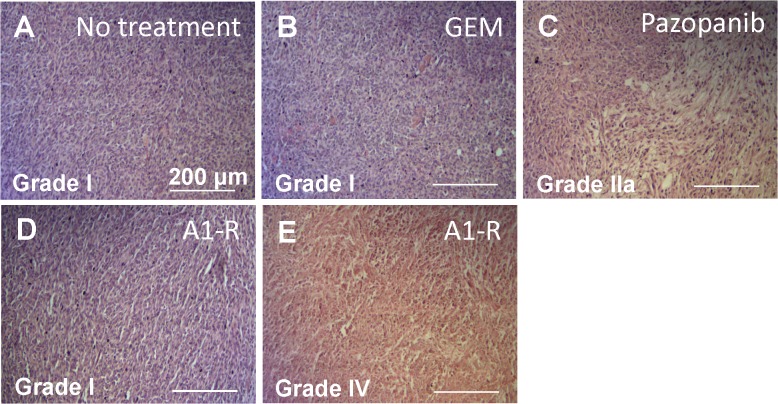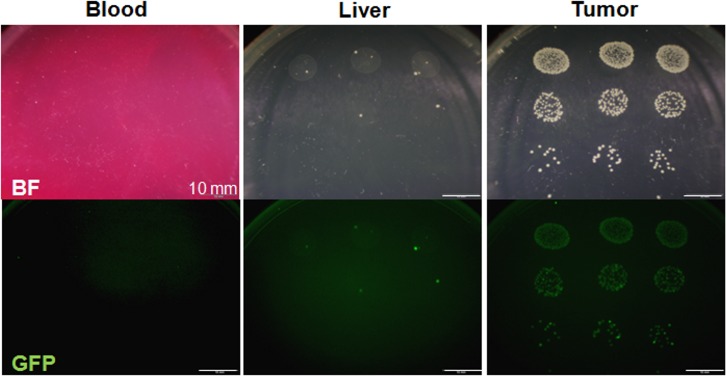Abstract
A patient-derived nude-mouse model of soft-tissue sarcoma has been established and treated in the following groups: (1) untreated controls; (2) gemcitabine (GEM) (80 mg/kg, ip, weekly, 3 weeks); (3) Pazopanib (100 mg/kg, orally, daily, 3 weeks) and (4) Salmonella typhimurium A1-R (5 × 107 CFU/body, ip, weekly, 3 weeks). The sarcoma was resistant to GEM (p = 0.879). Pazopanib tended to reduce the tumor volume compared to the untreated mice, but there was no significant difference (p = 0.115). S. typhimurium A1-R significantly inhibited tumor growth compared to the untreated mice (p = 0.001). S. typhimurium A1-R was the only effective treatment for the soft-tissue sarcoma nude mouse model among all treatments including a newly approved multiple tyrosine kinase inhibitor; Pazopanib. These results suggest tumor-targeting S. typhimurium A1-R is a promising treatment for chemo-resistant soft-tissue sarcoma.
Introduction
Soft-tissue sarcomas are rare mesenchymal cancers comprising approximately 50 histological types [1]. The yearly incidence of soft-tissue sarcomas in the USA is 11,280 cases, with 3,900 deaths. Patients with metastatic soft-tissue sarcomas have a median overall survival of about 12 months.
Pazopanib (Votrient) is a multiple tyrosine kinase inhibitor approved for the treatment of advanced (unresectable and/or metastatic) soft-tissue sarcomas in patients who have received prior chemotherapy. Pazopanib improved progression-free survival in a Phase III clinical trial [2].
An attenuated strain of Clostridium novyi (C. novyi-NT) was used to treat a human patient who had an advanced leiomyosarcoma. Treatment was intratumor (i.t.) injection of C. novyi-NT spores. C. novyi-NT regressed the tumor within and surrounding the bone [3].
Our laboratory has previously developed a genetically-modified bacteria strain, Salmonella typhimurium A1-R, selected for tumor-targeting in vivo. S. typhimurium A1-R is auxotrophic for leu and arg [4]. The strain targets and grows in tumors. In contrast, normal tissue is cleared of these bacteria even in immunodeficient athymic mice. S. typhimurium A1-R is effective against prostate cancer [5], breast cancer [6, 7], pancreatic cancer [8–11], glioma [12, 13], lung cancer [14], fibrosarcoma [15] and osteosarcoma [16].
In the present study, we report the efficacy of S. typhimurium A1-R against a human patient chemo-resistant sarcoma growing in nude mice. Tumors growing in nude mice can faithfully replicate important features of the patient’s cancer, such as tumor markers even after passage [17, 18].
Materials and Methods
Animals
Male athymic nu/nu nude mice (AntiCancer Inc., San Diego, CA), 4–6 weeks old, were used in this study. Mice were kept in a barrier facility under HEPA filtration. Mice were fed with autoclaved laboratory rodent diet. All mouse surgical procedures and imaging were performed with the animals anesthetized by intramuscular injection of 50% ketamine, 38% xylazine, and 12% acepromazine maleate (0.02 ml solution). All animal studies were conducted with an AntiCancer Institutional Animal Care and Use Committee (IACUC)-protocol specifically approved for this study and in accordance with the principals and procedures outlined in the National Institute of Health Guide for the Care and Use of Animals under Assurance Number A3873-1.
Specimen collection
The patient provided informed written consent and samples were procured and the study was conducted under the approval of the Institutional Review Board of the UC San Diego Medical Center.
Establishment of patient nude mouse model of sarcoma
Tumor tissues were obtained from the patient with a metastatic soft-tissue sarcoma of the retroperitoneum at biopsy and cut into fragments (3-mm3) and transplanted subcutaneously in nude mice. Tumors in the present study were in their second passage.
Preparation of bacteria
S. typhimurium A1-R was grown overnight on LB medium and then diluted 1:10 in LB medium. Bacteria were harvested at late-log phase, washed with PBS, and then diluted in PBS. Bacteria were then used for experiments [6].
Treatment of soft-tissue sarcoma in nude mice
The patient sarcoma established in nude mice was passaged subcutaneously to 20 nude mice to determine the efficacy of various treatments. Four weeks after implantation, the mice in each model were randomized to 6 mice in the untreated control and 4 groups of 5 mice in each treatment group and treated as follows: (1) untreated control; (2) gemcitabine (GEM, Eli Lilly and Company, Indianapolis, IN, USA) (80 mg/kg, ip, weekly, 3 weeks); (3) Pazopanib (Selleck Chemicals, Houston, TX, USA, 100 mg/kg, orally, daily, 3 weeks) and (4) S. typhimurium A1-R (5 × 107 CFU/body, ip, weekly, 3 weeks). Tumor size was evaluated every 3 to 4 days by caliper measurements. The approximate volume of the mass was calculated using the formula 4/3π• (d/2)2• D/2, where d is the minor tumor axis and D is the major tumor axis. Body weight of the mice was measured on a balance once a week. Relative tumor volume and body weight were calculated by comparison to Day 1. The endpoint of the experiment was when tumor size in the untreated control mice became approximately 2 cm. The method of euthanasia was CO2 inhalation.
Tissue histology
Tumor samples were removed with surrounding normal tissues at the time of resection. Fresh tissue samples were fixed in 10% formalin and embedded in paraffin before sectioning and staining. Tissue sections (5 μm) were deparaffinized in xylene and rehydrated in an ethanol series. Hematoxylin and eosin (H & E) staining was performed according to standard protocols. The sections were examined using a BH-2 microscope (Olympus, Tokyo, Japan) equipped with a INFINITY1 2.0 megapixel CMOS digital camera (Lumenera Corporation, Ottawa, Canada). All images were acquired using INFINITY ANALYZE software (Lumenera Corporation) without post-acquisition processing.
Evaluation of histopathological response to treatment
Histopathological response to treatment was defined according to Evans’s grading scheme: Grade I, little (<10%) or no cancer cell destruction is evident; Grade IIa, destruction of 10%-50% of cancer cells; Grade IIb, destruction of 51%-90% of cancer cells; Grade III, few (<10%) viable-appearing cancer cells are present; Grade IV, no viable cancer cells are present [11, 19].
Confocal imaging of S. typhimurium A1-R-GFP in sarcoma tissue
Resected sarcoma specimens from mice treated with S. typhimurium A1-R were embedded with optimal cutting temperature (OCT) compound (Tissue-Tek; Sakura Finetek Europe BV, Zoeterwude, Netherlands) and preserved in liquid nitrogen. Frozen sections of 7–10 μm thickness were prepared with a CM1850 cryostat (Leica, Wetzlar, Germany). The frozen sections were directly observed with a confocal microscope (Fluoview FV1000, Olympus, Tokyo, Japan). Excitation sources were semiconductor lasers at 473 nm for GFP excitation. After confocal imaging, frozen sections were fixed in 10% formalin and H & E staining was performed.
Culture of GFP-labeled S. typhimurium A1-R bacteria from tumors and organs
Subcutaneous tumors and normal nude mouse organs (blood and liver) were removed at the termination of the treatment experiments. Bacteria were isolated from the tumors and organs and cultured in LB agar for 24 hours, and imaged with the OV100 small animal imaging system (Olympus, Tokyo, Japan) [20].
Statistical analysis
PASW Statistics 18.0 (SPSS, Inc) was used for all statistical analyses. The Student’s t-test was used to compare continuous variables between two groups. A p value of 0.05 was considered statistically significant for all comparisons.
Results and Discussion
Soft-tissue patient sarcoma grown in nude mice recapitulates the histology of the original tumor
The majority of the original-tumor section was comprised of sarcomatous high grade spindle cells of varying sizes, demonstrating abundant, finely granular cytoplasm and atypical, pleomorphic, round–to-elongated nuclei with irregular nuclear membranes, an open chromatin pattern and prominent nucleoli (Fig 1A). The mouse-grown tumors had histological structures similar to the original tumor (Fig 1B).
Fig 1. Tumor histology.
A) Histology of the original patient sarcoma. B) Histology of the mouse grown sarcoma.
S. typhimurium A1-R is highly effective on the patient soft-tissue sarcoma in nude mice
The relative tumor volume on day 22, compared to day 1, of each group was as follows: (1) untreated control: 6.61 ± 2.37; (2) GEM: 6.39 ± 2.26; (3) Pazopanib: 3.94 ± 2.71; (4) S. typhimurium A1-R: 1.58 ± 0.37 (Fig 2). The sarcoma did not significantly respond to GEM (p = 0.879). Pazopanib tended to reduce the tumor volume compared to the untreated mice, but there was not a significant difference (p = 0.115). S. typhimurium A1-R significantly inhibited the sarcoma tumor growth compared to the untreated control mice (Fig 2) (p = 0.001). Sizes of all tumors are listed in the S1 Table. No body weight loss was found in any treatment groups.
Fig 2. Drug-response of soft tissue sarcoma in nude mice.
A representative image of nude mouse with the subcutaneous sarcoma in (A) the untreated mice; (B) GEM-treated; (C) Pazopanib-treated or (D) Salmonella typhimurium A1-R-treated. Scale bars: 10 mm. (E) Growth curves of the subcutaneous sarcoma’s treated with various drugs as described above. The values are mean relative tumor volume ± S.D. (bars) of five different tumors. ** p < 0.01, compared to no treatment group. (F-G) Representative cross-sections of excised subcutaneous tumors from the control and treatment groups with type of treatment indicated.
Histological response to treatment
Histopathological response to each treatment was defined according to Evans’s grading scheme. In the control (no treatment) and GEM-treated sections, the tissue sections from the tumor were occupied by viable cancer cells (Fig 3A and 3B). Approximately 40% of cancer cells were destroyed and replaced by stromal cells in the tumor sections treated with Pazopanib (Fig 3E). Tumors treated with S. typhimurium A1-R consisted of 2 components; one was a viable-like component and the other one was a necrotic component. The viable-like component was occupied by cancer cells (Fig 3D). In contrast, no viable cancer cell were detected in a necrotic component of the S. typhimurium A1-R-treated tumor (Fig 3E). Although the viable cancer cells were found, they did not form a tumor as can be seen from Fig 2. The untreated control and GEM were judged as grade I; Pazopanib as IIa; S. typhimurium A1-R of a viable-like component as grade I and the necrotic component as IV. The necrotic component was not detected in any treatment group except for S. typhimurium A1-R (Fig 3A–3E). Tumor heterogeneity may be a factor in the observed chemoresistance of the soft tissue sarcoma that was overcome by S. typhimurium A1-R.
Fig 3. Effect of treatment on histology in nude mice.
Histopathological responses to treatments were defined according to Evans’s grading scheme. (A) Treatment effect of control / no treatment was judged as grade I; (B) GEM treatment as grade I; (C) Pazopanib treatment as grade IIa; (D) S. typhimurium A1-R of a viable-like area as grade I and (E) S. typhimurium A1-R of a necrotic area as grade IV. Scale bars: 200 μm.
GFP-labeled S. typhimurium A1-R was isolated from the tumor (Fig 4), but not from blood and only minimally from liver, indicating the tumor was effectively targeted by S. typhimurium A1-R.
Fig 4. Tumor-targeting of S. typhimurium A1-R.
Distribution of GFP-labeled S. typhimurium A1-R in tumors and organs. Representative images of GFP-labeled S. typhimurium A1-R bacteria culture isolated from the tumor and the normal organs (blood and liver) of the mice treated with S. typhimurium A1-R. GFP-labeled S. typhimurium A1-R were clearly detected only in the tumor. Only a few GFP-labeled S. typhimurium A1-R were detected in the liver and no GFP-labeled S. typhimurium A1-R was detected in blood. Scale bars: 10 mm.
S. typhimurium A1-R was the only effective treatment for the soft-tissue patient sarcoma growing in nude mice including GEM and a newly approved multiple tyrosine kinase inhibitor; Pazopanib. One factor in chemoresistance of solid tumors is that the majority of the cancer cells within the tumor are in a chemoresistant G0/G1 quiescent cell-cycle phase [21]. We have recently shown that quiescent cancer cells are sensitive to S. typhimurium A1-R [22]. S. typhimurium A1-R, unlike C. novyi-NT, is a facultative anaerobe and can be administered systemically such as in the present study (i.p.), whereas C. novyi-NT seems to require i.t. administration which makes it different to target metastasis. The results of the present study indicate tumor-targeting S. typhimurium A1-R is a promising treatment for soft-tissue sarcomas. In future experiments, S. typhimurium A1-R will be tested in a series of patient soft tissue sarcoma grown in mice as a bridge to the clinic, where we also intend to focus on sarcoma.
Evaluation of biomarker expansion under various treatment regimens will be evaluated in future experiments.
Supporting Information
(DOCX)
Acknowledgments
This study was supported in part by National Cancer Institute grant numbers CA183280 and JSPS KAKENHI grant numbers 26830081 to YH, 26462070 to IE and 24592009 to KT. The funders had no role in study design, data collection and analysis, decision to publish, or preparation of the manuscript.
Dedication
This paper is dedicated to the memory of A. R. Moossa, M.D. and to the memory of James (Barney) Berglund, Jr., who inspired us to find improved therapy of soft-tissue sarcoma.
Data Availability
All data underlying the findings in our study are freely available in the manuscript.
Funding Statement
This study was supported in part by National Cancer Institute grant numbers CA183280 and JSPS KAKENHI grant numbers 26830081 to YH, 26462070 to IE and 24592009 to KT. AntiCancer, Inc., provided support in the form of salaries for authors [MZ, YZ, NZ]. The funders had no role in study design, data collection and analysis, decision to publish, or preparation of the manuscript.
References
- 1. Clark MA, Fisher C, Judson I, Thomas JM. (2005) Soft-tissue sarcomas in adults. N Engl J Med 353:701–711. [DOI] [PubMed] [Google Scholar]
- 2. van der Graaf WT, Blay JY, Chawla SP, Kim DW, Bui-Nguyen B, Casali PG, et al. (2012) Pazopanib for metastatic soft-tissue sarcoma (PALETTE): a randomised, double-blind, placebo-controlled phase 3 trial. Lancet 379:1879–1886. 10.1016/S0140-6736(12)60651-5 [DOI] [PubMed] [Google Scholar]
- 3. Roberts NJ, Zhang L, Janku F, Collins A, Bai RY, Staedtke V, et al. (2014) Intratumoral injection of Clostridium novyi-NT spores induces antitumor responses. Sci Transl Med 6:249ra111 10.1126/scitranslmed.3008982 [DOI] [PMC free article] [PubMed] [Google Scholar]
- 4. Zhao M, Yang M, Li XM, Jiang P, Baranov E, Li S, et al. (2005) Tumor-targeting bacterial therapy with amino acid auxotrophs of GFP-expressing Salmonella typhimurium . Proc Natl Acad Sci USA 102:755–760. [DOI] [PMC free article] [PubMed] [Google Scholar]
- 5. Zhao M, Geller J, Ma H, Yang M, Penman S, Hoffman RM. (2007) Monotherapy with a tumor-targeting mutant of Salmonella typhimurium cures orthotopic metastatic mouse models of human prostate cancer. Proc Natl Acad Sci USA 104:10170–10174. [DOI] [PMC free article] [PubMed] [Google Scholar]
- 6. Zhao M, Yang M, Ma H, Li X, Tan X, Li S, et al. (2006) Targeted therapy with a Salmonella typhimurium leucine-arginine auxotroph cures orthotopic human breast tumors in nude mice. Cancer Res 66:7647–7652. [DOI] [PubMed] [Google Scholar]
- 7. Zhang Y, Tome Y, Suetsugu A, Zhang L, Zhang N, Hoffman RM, et al. (2012) Determination of the optimal route of administration of Salmonella typhimurium A1-R to target breast cancer in nude mice. Anticancer Res 32:2501–2508. [PubMed] [Google Scholar]
- 8. Nagakura C, Hayashi K, Zhao M, Yamauchi K, Yamamoto N, Tsuchiya H, et al. (2009) Efficacy of a genetically-modified Salmonella typhimurium in an orthotopic human pancreatic cancer in nude mice. Anticancer Res 29:1873–1878. [PubMed] [Google Scholar]
- 9. Yam C, Zhao M, Hayashi K, Ma H, Kishimoto H, McElroy M, et al. (2010) Monotherapy with a tumor-targeting mutant of S. typhimurium inhibits liver metastasis in a mouse model of pancreatic cancer. J Surg Res 164:248–255. 10.1016/j.jss.2009.02.023 [DOI] [PMC free article] [PubMed] [Google Scholar]
- 10. Hiroshima Y, Zhao M, Zhang Y, Maawy A, Hassanein MK, Uehara F, et al. (2013) Comparison of efficacy of Salmonella typhimurium A1-R and chemotherapy on stem-like and non-stem human pancreatic cancer cells. Cell Cycle 12:2774–2780. 10.4161/cc.25872 [DOI] [PMC free article] [PubMed] [Google Scholar]
- 11. Hiroshima Y, Zhao M, Maawy A, Zhang Y, Katz MH, Fleming JB, et al. (2014) Efficacy of Salmonella typhimurium A1-R versus chemotherapy on a pancreatic cancer patient-derived orthotopic xenograft (PDOX). J Cell Biochem 115:1254–1261. 10.1002/jcb.24769 [DOI] [PubMed] [Google Scholar]
- 12. Kimura H, Zhang L, Zhao M, Hayashi K, Tsuchiya H, Tomita K, et al. (2010) Targeted therapy of spinal cord glioma with a genetically-modified Salmonella typhimurium . Cell Prolif 43:41–48. 10.1111/j.1365-2184.2009.00652.x [DOI] [PMC free article] [PubMed] [Google Scholar]
- 13. Momiyama M, Zhao M, Kimura H, Tran B, Chishima T, Bouvet M, et al. (2012) Inhibition and eradication of human glioma with tumor-targeting Salmonella typhimurium in an orthotopic nude-mouse model. Cell Cycle 11:628–632. 10.4161/cc.11.3.19116 [DOI] [PMC free article] [PubMed] [Google Scholar]
- 14. Zhao M, Suetsugu A, Ma H, Zhang L, Liu F, Zhang Y, et al. (2012) Efficacy against lung metastasis with a tumor-targeting mutant of Salmonella typhimurium in immunocompetent mice. Cell Cycle 11:187–193. 10.4161/cc.11.1.18667 [DOI] [PMC free article] [PubMed] [Google Scholar]
- 15. Hayashi K, Zhao M, Yamauchi K, Yamamoto N, Tsuchiya H, Tomita K, et al. (2009) Cancer metastasis directly eradicated by targeted therapy with a modified Salmonella typhimurium . J Cell Biochem 106:992–998. 10.1002/jcb.22078 [DOI] [PMC free article] [PubMed] [Google Scholar]
- 16. Hayashi K, Zhao M, Yamauchi K, Yamamoto N, Tsuchiya H, Tomita K, et al. (2009) Systemic targeting of primary bone tumor and lung metastasis of high-grade osteosarcoma in nude mice with a tumor-selective strain of Salmonella typhimurium . Cell Cycle 8:870–875. [DOI] [PubMed] [Google Scholar]
- 17. Fu X, Guadagni F, Hoffman RM. (1992) A metastatic nude-mouse model of human pancreatic cancer constructed orthotopically from histologically intact patient specimens. Proc Natl Acad Sci USA 89:5645–5649. [DOI] [PMC free article] [PubMed] [Google Scholar]
- 18. Hiroshima Y, Zhang Y, Zhang M, Maawy A, Mii S, Yamamoto M, et al. (2015) Establishment of a patient-derived orthotopic xenograph (PDOX) model of HER-2-positive cervical cancer expressing the clinical metastatic pattern. PLOS ONE 10:e0117417 10.1371/journal.pone.0117417 [DOI] [PMC free article] [PubMed] [Google Scholar]
- 19. Evans DB, Rich TA, Byrd DR, Cleary KR, Connelly JH, Levin B, et al. (1992) Preoperative chemoradiation and pancreaticoduodenectomy for adenocarcinoma of the pancreas. Arch Surg 127:1335–1339. [DOI] [PubMed] [Google Scholar]
- 20. Yamauchi K, Yang M, Jiang P, Xu M, Yamamoto N, Tsuchiya H, et al. (2006) Development of real-time subcellular dynamic multicolor imaging of cancer cell trafficking in live mice with a variable-magnification whole-mouse imaging system. Cancer Res 66:4208–4214. [DOI] [PubMed] [Google Scholar]
- 21. Yano S, Zhang Y, Miwa S, Tome Y, Hiroshima Y, Uehara F, et al. (2014) Spatial-temporal FUCCI imaging of each cell in a tumor demonstrates locational dependence of cell cycle dynamics and chemoresponsiveness. Cell Cycle 13:2110–2119. 10.4161/cc.29156 [DOI] [PMC free article] [PubMed] [Google Scholar]
- 22. Yano S, Zhang Y, Zhao M, Hiroshima Y, Miwa S, Uehara F, et al. (2014) Tumor-targeting Salmonella typhimurium A1-R decoys quiescent cancer cells to cycle as visualized by FUCCI imaging and become sensitive to chemotherapy. Cell Cycle 13:3958–3963. 10.4161/15384101.2014.964115 [DOI] [PMC free article] [PubMed] [Google Scholar]
Associated Data
This section collects any data citations, data availability statements, or supplementary materials included in this article.
Supplementary Materials
(DOCX)
Data Availability Statement
All data underlying the findings in our study are freely available in the manuscript.






